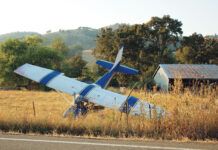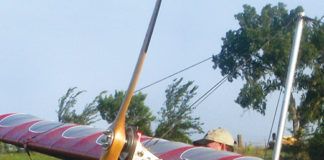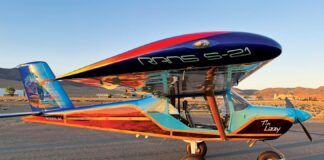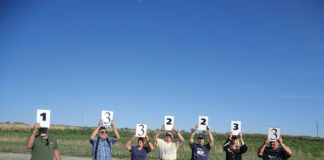The Stratux dual-band “In” receiver is an open-source version of the Stratus II without an AHRS. A separate output device such as a tablet, display, or smartphone is required.
This article is an update on what has happened in the ADS-B space since last year plus some other ADS-B items. It is a follow-up to “Juggling the ADS-B Options,” which appeared in the June 2016 issue. That article was framework for the decisions an owner needs to make about installing ADS-B.
The only point I would add to that article is that as more aircraft are “In” equipped, good citizenship would suggest that you should equip with “Out” to illuminate yourself as traffic. This is the same logic as turning on your landing lights and strobes during daylight to make yourself more visible. Similarly, as more targets have “Out,” you should install dual channel “In” to see them. Dual channel “In” is necessary to receive “Out” aircraft when outside of ground-based transmitter (GBT) coverage.
In the following discussion 1090 ES refers to a 1090 MHz extended squitter (ES) transponder and Universal Access Terminal (UAT) to a 978 MHz transceiver. “In” and “Out” in quotes and caps refer to ADS-B “In” and ADS-B “Out” functionality respectively.
FAA Deadline and ADS-B System Specifications
There has been no change in the FAA’s position that they will not extend the ADS-B equipment installation deadline nor has there been any indication the FAA will be changing the ADS-B system equipment specifications. My speculation is that any delay would not be announced until after the current FAA Administrator’s term is up in January 2018 or, more likely, just before the 2020 deadline. The FAA has stated they will not be sympathetic to procrastinators because of the long period since the regulations were passed. The FAA has a lot more skin in this game than just ADS-B for general aviation (GA). ADS-B is used for precision aircraft location, which is a cornerstone of many NextGen improvements.
FAA Statistics
The FAA has been quite open about issuing statistics on the progress of ADS-B “Out.” The statistics highlight several issues critical to owners. First is the market’s choice for “Out” frequencies. Second is the rate of failed installations. Third is the state of installations relative to the program’s nominal goals and the deadline. These will be explored in text and accompanying graphs. Due to publication deadlines, the statistics are as of the end of March 2017.
Frequencies Being Installed
The graph of installations by frequencies (Figure 1) shows a very telling difference between cumulative installations to date and installations in the last five months. The current installations are about 94% 1090 ES. Shops are corroborating that number anecdotally. It is felt the UAT’s cumulative installed to date is a higher percentage than recent history because some were from the Capstone Project in Alaska and the Gulf of Mexico projects that essentially prototyped the ADS-B system using UAT. Also some UAT transceivers were installed early on when 1090 ES “Out” and dual “In” units were not available.
There are some aircraft with both 1090 and 978 “Out” installations. The reason to have both 1090 ES and UAT “Out” installed is when out of GBT coverage, you will illuminate yourself air-to-air to all “In” aircraft regardless of their receiver frequencies. This is legal as long as one transmitter is suppressed when the other is transmitting.
The statistics beg the question is UAT “Out” dead? If it is not dead it is at least comatose. The proliferation of all-in-one 1090 ES boxes, their price competitiveness, usually simpler installation and the lack of international adoption of UAT has essentially doomed UAT “Out” to niche status.

Installation Failures
The FAA tracks failed installations, which in Fed speak are called non-performing emitters (NPE). Figure 2 shows the percentage of NPEs by aircraft type, which has remained surprisingly constant over time. The FAA statistics shows that the Experimental and Light Sport Aircraft (LSA) communities have done the poorest job of any of the categories of “Out” installations. At the end of March 2017, 44% of the installations fell into the NPE category. About 77% of those NPEs are insufficiently accurate GPS receivers. Shops feel the majority of other errors are software installation errors and not the failure of units to transmit.
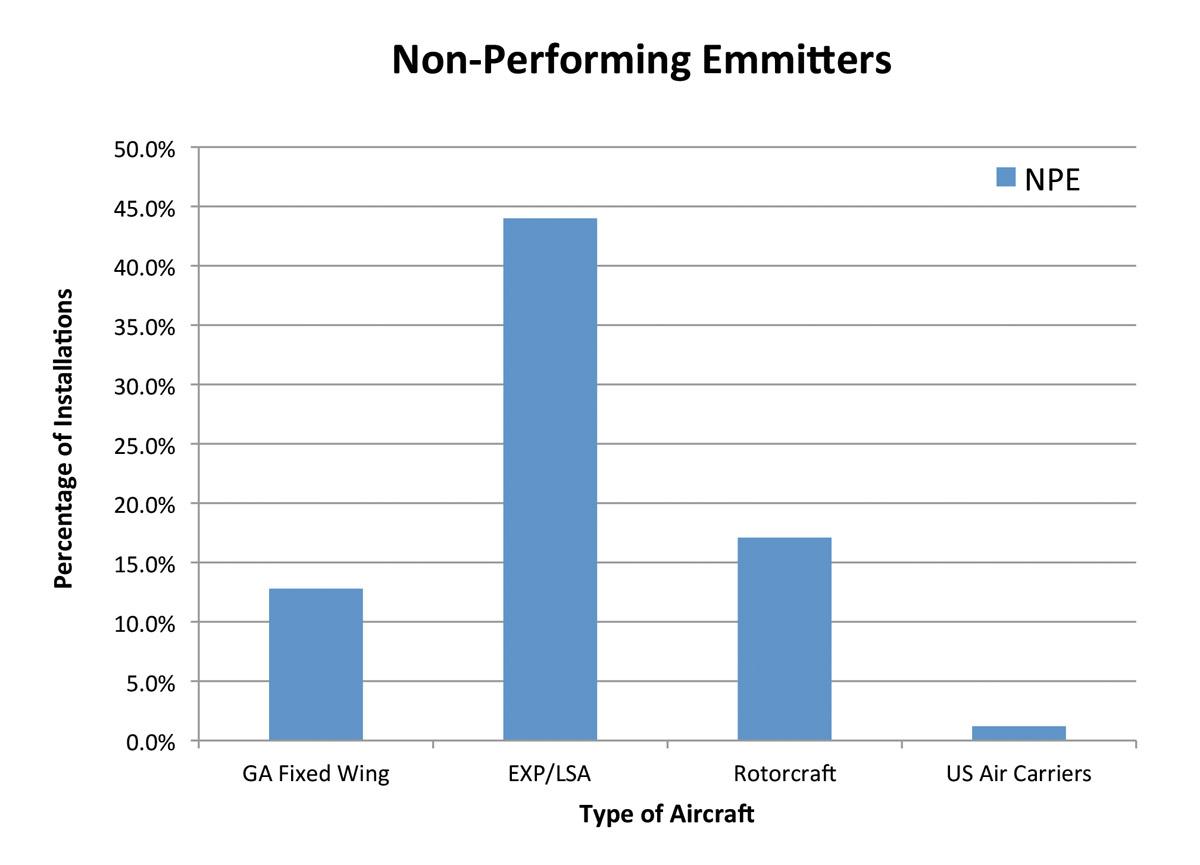
Status of Installations as of the End of March 2017
At the end of March 2017, the FAA showed 22,840 good GA “Out” installations (see Figure 3). That total includes LSAs and Experimentals. GA installations were 1161 in March 2017 and an average of 1107 per month for the first quarter of 2017. There was a notable bump up in the installation rate after the rebate program opened but has since tapered off. The FAA’s installation data comes from analysis of aircraft detected in the air.
Many pundits are using a total expected GA “Out” installation market size of 100,000 aircraft. This starts from an estimate of a GA fleet size of 160,000 less a roughly 20% that are estimated not to use ADS-B required airspace and another approximately 20% that are estimated to be hangar queens. The resultant market was then rounded down to a nice number that is easy to compute with!
Forecasting achieving or missing a goal of 100,000 GA installations by 2020 is problematic. That is because no one knows for sure the number of installations that will ultimately be needed or the capacity of the market to do installations.
Looking at the graph, if you believe in linear growth, the goal will not be achieved. If you believe in geometric growth it could be. My guess is the installations by 2020 will end up in the mid-range of the number of remaining installations.
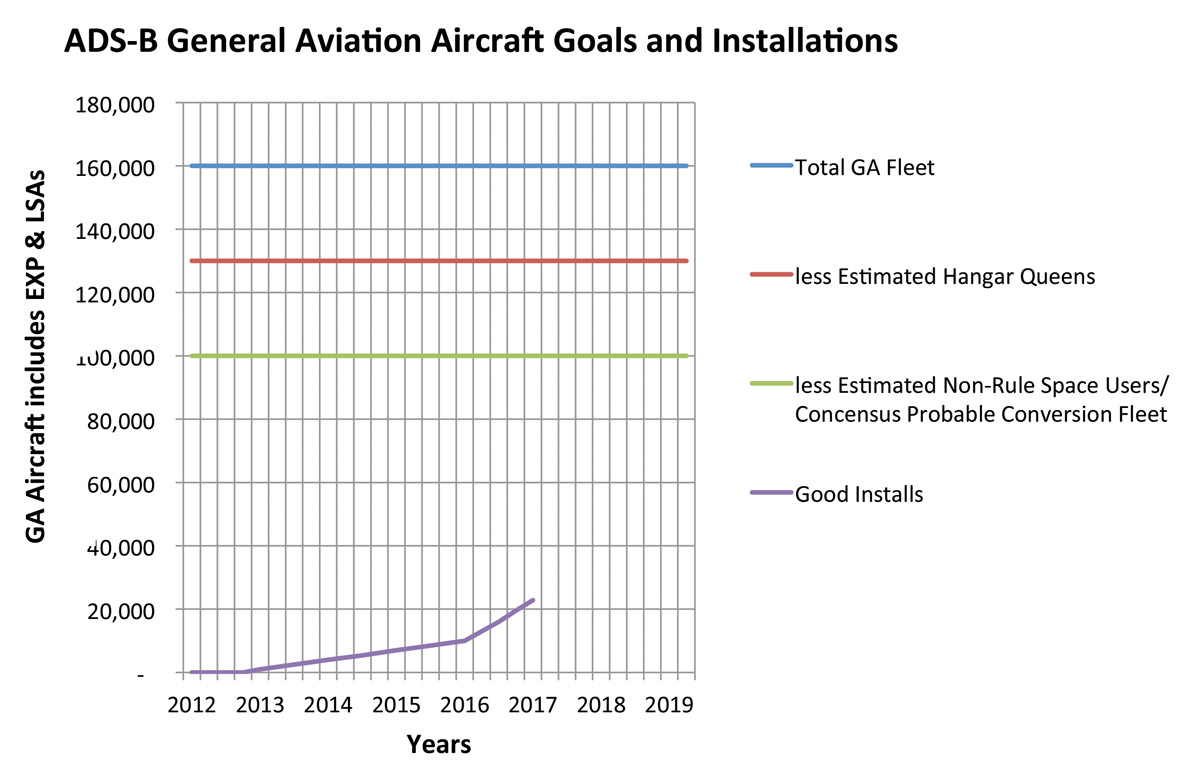
Hardware Offerings
There have been no new “Out” hardware offerings since last summer by the big current suppliers. They seem to be set for the duration. Some new as yet minor players have come into the market. uAvionix announced a new 1090 ES transponder at Sun ‘n Fun that seems to set a new lower price point for 1090 ES “Out” and a new small size. They already offered a similarly small UAT transceiver. Another company announced they were going to announce a UAT transceiver enclosed in a blade antenna at Oshkosh. It remains to be seen if these are “disruptive technologies.” These units are as yet not TSO’d, so it is buyer beware of claims to comply with the TSO but not having a certificate.
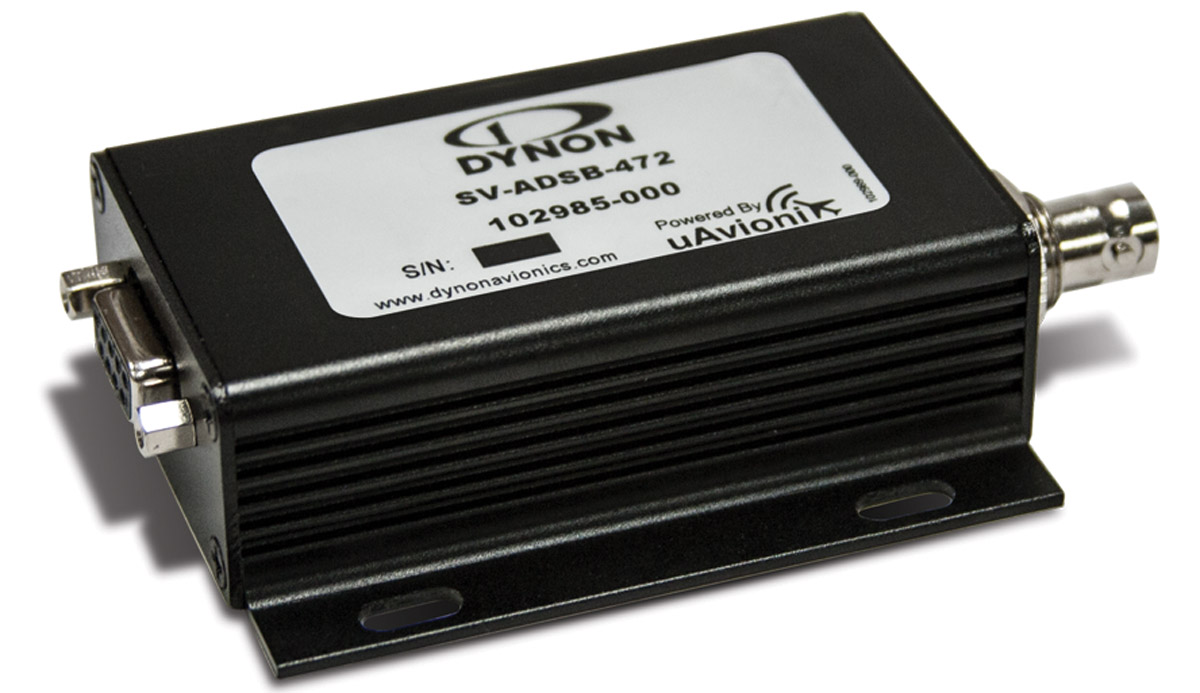
Shops report that 1090 ES transponders with an integral certified GPS receiver and dual-band “In” are the winners in the marketplace. This is the so-called “slip-in” market and uses the traditional in-panel transponder form factor. The “In” function either uses an integral display, hooks up to an existing display, or provides wireless connectivity to another output device. The GPS is not shared with a navigator. This is a natural for older aircraft without a certified WAAS navigator and isn’t subject to navigator software upgrades.
There continue to be new announcements of “In” receivers with almost universal offering of Wi-Fi connectivity to in-panel displays or tablets. Many also offer AHRS/auxiliary panel functions, too. The segment seems to be more dynamic because portable “In” units do not have to meet the requirement of a TSO.
The Stratux dual-band “In” receiver continues to generate considerable interest in the Experimental space. The unit is basically an open-source version of the popular Stratus II without an AHRS function. A separate output device such as a tablet, display, or smart phone is required. Since it is dual-band “In,” you receive “Out” traffic transmissions air-to-air. You will not receive non-ADS-B aircraft secondary radar targets unless you generate a hockey puck (i.e., you are “Out” equipped) and are within both radar and GBT coverage. The cost for the kit is about $130. The kit is easily assembled. Reception performance seems to be less than installations with externally mounted antennas. FlightBox manufactures an already assembled version of the Stratux.
L3’s Lynx is an all-in-one Mode S 1090 extended squitter transponder with 1090 MHz and 978 MHz ADS-B “In.” Shown on the touchscreen display is traffic and terrain awareness.Avionics Shop Perspective
I interviewed several avionics shops in the Denver area as well several avionics industry experts. The current and expected installations through 2017 are seen as being owners who see “In” advantages. Shops expect the 2018-2019 customers to be more of the minimal rule compliant type/no frills installations that may opt for UAT because it may be nominally cheaper. An industry-wide installation crunch did not exist at the end of March 2017. Avionics shops and the industry association expect there will be a crunch in 2018-2019.
Shops are hiring additional help, but this appears to be mainly a function of robust hiring across the industry rather than for ADS-B installations. As one shop put it, they are always looking for good reliable people, but those requirements are hard to meet.
Typical shop lead times are 30-90 days and fairly static. There is some seasonality with longer lead times in the spring getting ready for the flying season. Some of that lead time is the normal backlog that always exists for custom work. Typical “Out” installations are three days but can average eight days if there are “In” or other upgrades. Shops stress each job is unique and is bid as such and is always subject to surprises. There are no flat-rate guides for installations like those for automobile repairs! Shops are typically not requiring pre-paid installation reservations or equipment deposits.
Many shops have test equipment that can verify the installation is working correctly before the aircraft leaves the shop. This is especially important for a shop, as they don’t want to see you twice for the same job. It is important for you if you are flying to a distant home base. A shop installation should include a guarantee that the installation will pass the FAA’s verification test.

If you are considering a shop install, they stress it is important to talk with them now. They can use their experience to help you finalize the configuration for your mission and pocketbook. If you have a favorite brand or need to integrate with a particular flight management system, then you need to find the correct shop. Shops have a learning curve with the manufacturers they do carry. If you engage them for work that is not in their experience base, it will cost you more. Most shops will work on all brands of equipment, but as one person put it, you wouldn’t take a Chevy to a Ford shop even though they could work on your car. Finally, you need to establish a relationship with a shop so you won’t be a walk-in-cold situation when you pull the trigger. By talking to a shop now, you can get a feel for the work quality, find out about their on-time performance, and get references. They will be able to ascertain if any of your legacy equipment like GPS receivers, displays, encoders, etc. can be logically reused. Be aware that for certified aircraft, a given transponder model can only be paired with specific GPS sources.
Avionics shops are surprisingly open to installations on Experimental aircraft. This is in part because Experimental owners are in general more knowledgeable about ADS-B, know their aircraft better, and are passionate about the job being done right.
Changes in International Requirements
The generally slow pace of global adoption of ADS-B continued in 2016. Mexico recently announced a 1090 ES requirement for January 1, 2020 that largely mimics the U.S. “rule airspace” rules. Canada and the Caribbean countries have not moved toward mandatory adoption. No country other than the U.S. has implemented UAT.
ADS-B and UAS/drones
There is considerable research and marketplace activity on the UAS/drone side on collision avoidance with aircraft. Many schemes are being talked about. This seems to be driven from the UAS side where they want to fly out of line of sight and closer to airports. A UAS utilizing UAT “Out” could be received by an airplane with UAT “In” in air-to-air mode without having to be in GBT coverage. Because of frequency congestion, 1090 MHz “Out” for drones is a non-starter. To be clear, as of yet, there are no FAA regulations for “Out” or “In” for UAS/drones or for “In” for aircraft. Since UAS/drones are weight sensitive, they are driving miniaturization.
FAA Equipage Rebate
The FAA’s $500 equipage rebate program commenced in September 2016. It came with specific gates that must be met by the applicant. The critical element was that it applied to “Out” only, in single-engine piston aircraft registered before 2016 with required TSO’d equipment. Incidentally, the FAA says the rebate is taxable income.
Avionic shops have termed the rebate program as “disappointing” in impact. However, they do not report difficulty with the aircraft owners obtaining the rebates. They say the rebate program is drawing in fence sitters rather than the unaware about ADS-B. As of the end of March 2017, about 5000 of the 20,000 rebates had been reserved. The publication date of this article is near the expiration date of the program, so watch the press for further information.
Light Sport Aircraft
Light Sport Aircraft (LSA) is a continuing source of confusion about permissible ADS-B options. The confusion arises because the “Out” and “In” equipment that can be used is a function of how the LSA was manufactured. For factory-built LSA (SLSA) and amateur-built to factory specifications (ELSA), the ADS-B equipment that is installed and the method of installation must be factory approved. An E/A-B LSA is like any other Experimental aircraft in that you can install any equipment you desire as long as it meets a TSO performance specification. Note that some heritage aircraft that comply with the LSA rules are, in fact, certified and must follow the certified rules and use TSO’d equipment.
Because of their limited performance, a smaller percentage of LSAs are expected to elect to install “Out” and more may choose to install UAT rather than 1090 ES.
Installing as Part of an Annual
If you are not self-installing, it may be tempting to have your equipment installed by an airframe and powerplant mechanic (A&P) if you are using one for your annual or condition inspection. This is attractive as the airplane is already down and probably halfway torn apart. This approach is subject to the complexity of the work being done and the electronics savvy of the A&P. That person is unlikely to have access to ground test equipment for demonstrating ADS-B performance, complex system integration knowledge, or sophisticated debugging experience. Also you will need the services of an A&P with Inspection Authorization (IA) to sign off if the install is part of a major modification on a certified aircraft. Unfortunately some avionics shops have ended up debugging some of those A&P installations. That raises their ire. They have missed the installation revenue and inherited a problem situation not of their own making.
ADS-B “Out” Usage
Both transponders and “Out” (1090 ES or UAT) equipment must be operated in altitude reporting mode for transponders and transmit mode for “Out” equipment prior to moving on the airport surface and at all times when in flight. This is true regardless of operating in “rule airspace” or not. This is true now even though you are not required to have “Out” until January 1, 2020. If you have ADS-B installed you must use it!
Anonymous Mode
A little known feature of ADS-B is what is known as anonymous mode, which only applies to UAT “Out.” Anonymous mode is the ability to have the aircraft’s identity “anonymized” under certain very limited conditions. You still have to have “Out” operating in flight; it is just that decipherable aircraft identification is not being transmitted. A user must keep track of the operating rules and only use the anonymous mode when appropriate. If you are using 1090 ES “Out,” your identification information is always being transmitted.
Anonymous mode may only be used in “rule airspace” when the pilot has not filed a flight plan and is not requesting ATC services and is squawking 1200. If you are entering Class B or Class C airspace, you will be requesting ATC services and cannot use anonymous mode. Logically this would also include communications with a tower in Class D airspace.
Shops report users are generally unaware of anonymous mode and even if they do know, they don’t request its installation. It is unclear how practical anonymous mode will be. In the end the FAA could probably still track you down through post-event analysis for a violation.
Resources
Aside from websites cited in my previous article, you should check out the AOPA website. AOPA has been writing ADS-B specific materials for some time. These articles have ranged from fundamentals, to experiences installing equipment in legacy aircraft, to user flight experiences. The easiest access is to go to www.AOPA.org, then click on the search magnifying glass in the top right-hand corner. Enter ADS-B in the window and click “search.” A long list of articles will appear, the best of which are by Mike Collins, their ADS-B point man.
Not Very Fearless Forecast
For the balance of 2017 I predict continued 1090 ES “Out” dominance. I anticipate continued outreach effort by the FAA to get rid of NPE issues. Shops will show modest increases in installation lead times but no full-fledged crunch. I predict more offerings in the marketplace for drone-based “Out” equipment to announce UAS locations to help avoid collisions with aircraft.
Summary and Conclusion
Another year has passed. Installations are slowly progressing with avionics shop lead times still reasonable. All-in-one ADS-B 1090 ES “Out” and dual “In” boxes are the big winners. Most buyers are also installing some form of “In.” Safe flying until next year’s update!
Next in series: Time is Running Out!











